Ama Dablam Diary Part 1

Ellis Brigham sponsored mountaineer Calum Mallory spent the past two years preparing to tackle one of the toughest and most distinctive peaks in the Himalaya, Ama Dablam. The mighty summit pinnacle looms above the Everest Base Camp trekking route, and demands technical skill, excellent fitness, determination and a little bit of luck. In the first of two posts, Calum recounts his journey to the Base Camp of this Nepalese behemoth...
Whilst packing my bags ready to leave for Nepal the following day I reflected on the journey it had been leading up to this moment. It was two years ago that I had decided to climb Ama Dablam and not long after started training for it. Thousands of hours of running, training, climbing and money all led up to this moment. I wasn't sure what to expect as this would be my first trip to the Himalaya. I was excited to go but also very nervous for what lay ahead. Questions ran through my mind; have I put in enough training? Am I mentally prepared for this? I think the truth is you will never feel ready until you're standing at the base of the mountain looking up and getting psyched. The time had come to say goodbye to friends and family and board the plane bound for the crazy city of Kathmandu. There were many mixed emotions as I said goodbye but I couldn't wait to start the adventures.
Arriving in Kathmandu was a shock to me. This was the first country I had been to that was still quite up and coming. I instantly loved the hustle and bustle of the city and their total lack of traffic laws.
That night at the hotel the team all met for the first time over some beers, and we all instantly knew we would get along well on what was going to be one of the biggest adventures of our lives.
Our team of seven included Mountain Expeditions leader Jon Gupta, Everest summiteer and good friend Mollie Hughes, Polar explorer and world record holder Karin Bojsen from Holland, the very funny and life of the party Gordon Booth from Ireland, Chris Oehlert with many previous expeditions, alpine climber Paul, and myself.
I already knew Mollie and Jon before the expedition. We have many awesome climbing trips from Mont Blanc, Norway and Scotland and it was Mollie who told me I should come and climb Ama Dablam with her after I heard about her first attempt at it in 2012. I first met Jon through Mollie and together we'd set a new world record of climbing the height of Mount Everest in an indoor climbing wall in the Covent Garden shop of my sponsors Ellis Brigham.
I had never met any of the others but had heard great things about them through Mollie and Jon. The team were strong mountaineers and boasted an impressive mountaineering CV between them all. It was great to be a part of such an experienced and strong team. The energy within the group was electric and everyone instantly got on with one another.
Two days of expedition prep and some last minute kit purchases in Kathmandu and we were set to fly to Lukla. I had first heard about Lukla airport ten years before on a TV programme "The World's Most Dangerous Airports" and instantly wanted to fly to this small strange airstrip that rested on the edge of a mountain. As we boarded the small ten-man plane we were overcome by adrenaline. The short flight to Lukla was filled with stunning views of the mountains and microscopic villages resting on the hillsides. The bumpy ride was over too soon as we made our descent onto the extremely short runway. Landing was a relief for many of the team as they were not fans of flying in large commercial aircrafts let alone a small dingy plane!
We were now on the start of the Everest trail and trek to our base camp. We passed through tiny villages and saw the locals going about their everyday lives, and the trail was busy with Everest base camp trekkers from all over the world. Long lines of porters and yaks carried heavy loads alongside them. The first day was filled with views of the alpine forests and the high rising valleys all around with the sound of rushing white water from the rivers below. Our night's stay on the trail would bring us to the village of Monjo. This was the first tea house I had stayed in and instantly loved the simplicity of the place and life of the Khumbu people.

The evening was spent sitting around a log (and Yak poo) fire, talking away and sharing stories about our past expeditions and experiences in the mountains, or for Karin her record-breaking polar expeditions. The next morning we woke to a beautiful blue sky and shortly after some good Nepalese breakfast of two eggs and a chapatti we were back on the trail again. Today we would trek up to the village of Namche Bazaar. This is the main trading centre and tourist hub for the Khumbu region (it even has an Irish bar!) We loaded up and got fat on the exceedingly good chocolate cake from the Everest bakery, before making our way to the next village for a couple of nights to acclimatise. It was here at the Ama Dablam view lodge that we had our first real good look of our target peak. Although she was covered in cloud we were still able to really understand the size and steepness of the mountain. After an acclimatisation hike and another night at the lodge, we were moving on to Khumjung, home to the Hillary School.
The centre was established by Sir Edmund Hillary, the first person to summit Everest with Tenzing Norgay and the Himalayan trust in 1961, in order to give a good education to the children of the Khumbu region. We had arrived at a good time in Khumjung and just in time to see the local villagers singing and chanting at a religious ceremony dressed in their best traditional Nepali clothing. The next morning we were off to our last tea house of the trek to base camp at the village of Pangboche, sitting high up on the Everest trail. It was here that we would receive our first Puja by the oldest and wisest Lama in the Khumbu region, Lama Gesche. Lama Gesche was a very funny and energetic character and performed our two hour ceremony. A Puja is an offering to Buddha for the safe passage and protection in the mountains. We all drank tea and listened to him sing and chant before before he got us to join in with him to sing "oh mani padme hum" over and over again. "Oh mani padme hum" is a mantra and stands for generosity, ethics, patience, diligence, renunciation and wisdom. It is commonly carved onto rocks or written on paper which is inserted into prayer wheels. When an individual spins the wheel, it is said that the effect is the same as reciting the mantra as many times as it is duplicated within the wheel.

When the Puja was complete Lama Gesche presented us with our silk scarves or Tib. Kha-btags to be exact. With the blessing of Lama Gesche and another cold night in Pangboche, we were now ready to reach base camp where we would spend the next three weeks.
We arrived at base camp and the following day we packed enough food, supplies, and gas to last us for three days on the mountain put them into our packs and made our first trip up the hill, soon to be known as 's**t hill 1' due to the neverending slog straight out of the camp. We would spend a night at advanced base camp then tag Camp 1 so we could acclimatise our bodies to the altitude. When climbing at altitude it is vital that you acclimatise to the conditions so that you do not get AMS (Acute Mountain Sickness) or HAPE (High Altitude Pulmonary Edema).
AMS is caused by reduced air pressure and lower oxygen levels at high altitudes and can have severe effects on the body. HAPE is more extreme and can be deadly. It is caused by a build up of fluid in the lungs and brain due to the altitude. These symptoms are quite common in when climbing the Himilaya and can have deadly effects. In order to avoid this and acclimatise well, you must climb up to a certain height and expose your body to the altitude, then come back down to an altitude that your body has already adapted to. This causes your body to rapidly create more red blood cells meaning that your body has more oxygen in the blood than usual. This process is repeated many times, each time exposing your body to higher elevations. Acclimatisation is the biggest and most important part of an expedition, and should be used to test your body and see how well you're coping with the altitude and how hard you can push yourself before even thinking about a summit attempt.






